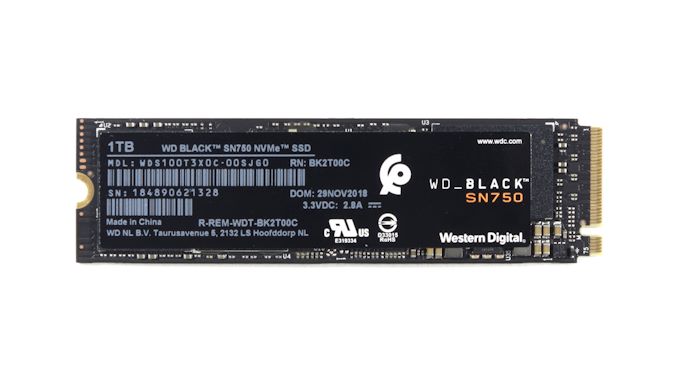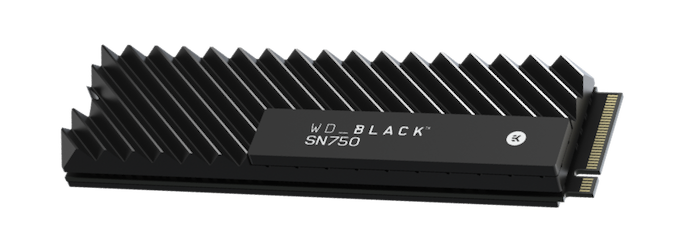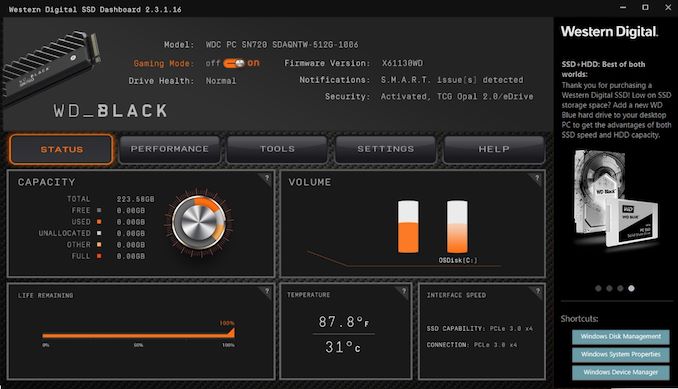The Western Digital WD Black SN750 SSD Review: Why Fix What Isn't Broken?
by Billy Tallis on January 18, 2019 8:01 AM EST
Last year Western Digital overhauled their WD Black NVMe SSD with an upgrade to 3D NAND and a new in-house SSD controller, transforming the product line from one of the slowest NVMe drives to one of the top high-end competitors. Now the third generation WD Black SSD is here, with the model number SN750 to avoid confusion with its predecessors. (Internally, last year's model was known as the SN700, and the OEM version was the SN720.) The new WD Black SN750 is an incremental update over last year's model, keeping the same basic controller and 64L 3D NAND combination but refining the firmware and adding a 2TB option. Western Digital is also shifting their marketing efforts more toward gamers with the addition of SKUs featuring a large heatsink.
The second-generation WD Black launched last year delivered performance that is generally competitive with other top NVMe SSDs like the Samsung 970 EVO, while usually operating with far better power efficiency. The only other high-end NVMe SSDs that have similar efficiency are the Toshiba XG5 and XG6, but the controller they use puts them clearly in a lower performance class than the WD Black. However, last year's model was still the first release of a new controller architecture, so it is no surprise that Western Digital has some firmware improvements to deliver. It is a bit disappointing that those improvements aren't being distributed as free firmware updates to owners of last year's model, but Western Digital is not the only company that's taken this approach.
| Western Digital WD Black SN750 Specifications | ||||||
| Capacity | 250 GB | 500 GB | 1 TB | 2 TB | ||
| Form Factor | M.2 2280 single-sided optional heatsink (except 250GB) |
|||||
| Interface | PCIe 3 x4 NVMe 1.3 | |||||
| Controller | Western Digital in-house | |||||
| NAND Flash | SanDisk 64-layer 3D TLC | |||||
| Sequential Read | 3100 MB/s | 3470 MB/s | 3470 MB/s | 3400 MB/s | ||
| Sequential Write | 1600 MB/s | 2600 MB/s | 3000 MB/s | 2900 MB/s | ||
| Random Read | 220k IOPS | 420k IOPS | 515k IOPS | 480k IOPS | ||
| Random Write | 180k IOPS | 380k IOPS | 560k IOPS | 550k IOPS | ||
| Power | Peak | 9.24 W | 9.24 W | 9.24 W | 9.24 W | |
| PS3 Idle | 70 mW | 70 mW | 100 mW | 100 mW | ||
| PS4 Idle | 2.5 mW | 2.5 mW | 2.5 mW | 2.5 mW | ||
| Warranty | 5 years | |||||
| Write Endurance | 200 TB 0.4 DWPD |
300 TB 0.3 DWPD |
600 TB 0.3 DWPD |
1200 TB 0.3 DWPD |
||
| MSRP (No heatsink) |
$79.99 | $129.99 | $249.99 | $499.99 | ||
Aside from the addition of the 2TB option, the most noticeable changes to the specs table are the vastly lower MSRPs: the 2TB will debut for only $50 more than the 1TB model was at introduction last year, and the smallest price drop is the 33% cut to the 250GB model's price tag.
Performance has been improved slightly across most of the major metrics, but none of the improvements are anything huge. The 2TB model will actually be slightly slower than the 1TB, due in part to using 512Gb NAND dies instead of 256Gb dies so that the 2TB model can still be a single-sided M.2 card.
The 2TB model and the SKUs equipped with heatsinks will be arriving this spring, but the plain 250GB through 1TB models ship this month. Western Digital has not provided MSRPs for the models with heatsinks, but we expect them to carry a bit of a premium when they arrive.
Peeking under the label, we find essentially the same PCB as last year's model, though it appears we've gone from revision A to revision D. The WD Black SN750 is equipped with the same controller and NAND parts as last year's WD Black and SanDisk Extreme Pro, and the only differences in chip markings appear to be date codes or lot numbers.

Top: 2nd Gen WD Black (SN700)
Bottom: 3rd Gen WD Black SN750
Unlike last year's model, the new WD Black SN750 does not have a sibling product under the SanDisk brand; the SanDisk Extreme Pro NVMe SSD is now strictly speaking an outdated product, though it is still very similar to the new WD Black.
Western Digital has made a few superficial changes to the WD Black to make it more gamer-oriented. The product packaging and labeling has been restyled, and all but the smallest model will soon be available in versions with a custom aluminum heatsink from EKWB. Additionally, there's a new version of Western Digital's new SSD Dashboard software for Windows that adds a "Gaming Mode" which re-configures the NVMe driver to not enable Autonomous Power State Transitions. When this gaming mode is enabled, the drive won't make use of its low-power idle states, which avoids the extra latency of waking the drive up after it has been idle for a few seconds. However, in our experience few gaming desktops are configured to use the deepest idle states, and the WD Black wakes up very quickly from its intermediate idle, so this feature will be inconsequential for most users.
Our Linux-based synthetic performance tests are already conducted with APST off so that idle wake-up latency doesn't distort those results. Our Windows-based ATSB trace tests leave APST enabled, but the trace playback cuts idle times short enough that most NVMe drives won't be entering low-power states during those tests, either. The SYSmark 2018 test gives SSDs plenty of idle time to make use of their deepest idle states, but overall the workload it presents is not storage-intensive enough for WD's Gaming Mode to have a noticeable effect.
It may seem odd that Western Digital is sticking with their 64-layer 3D NAND even months after their partner Toshiba started shipping 96L 3D NAND with the XG6, but the transition to 96L NAND will look very different from the transition to 64L NAND. The 64L generation leveled the playing field as Toshiba and Western Digital delivered their first 3D NAND worth mass producing, and Intel and Micron made significant performance improvements over their previous 32L NAND. As most of the major manufacturers largely caught up to Samsung and ramped up production, prices crashed. That's been great news for consumers, but has prompted the manufacturers to slow their investments into 96L production to avoid worsening the oversupply. Thus, we expect the 96L transition to proceed more slowly, taking all of 2019 and probably into 2020 before every 64L product line gets upgraded. The 96L upgrade has the potential to bring some significant performance and power improvements, but will in most cases require a new generation of controllers that can take advantage of higher controller-to-NAND interface speeds or lower operating voltages.
Since last year's WD Black launched, the most important new competitors to hit the scene have been drives based on Intel/Micron NAND with the SM2262 controller, and drives using the same Toshiba/SanDisk NAND with the Phison E12 controller. The SM2262 drives (represented in this review by the HP EX920) are now being phased out in favor of the upgraded SM2262EN controller, which we previewed last year. Representing the Phison E12 family, we have the Corsair Force MP510 960GB.
| AnandTech 2018 Consumer SSD Testbed | |
| CPU | Intel Xeon E3 1240 v5 |
| Motherboard | ASRock Fatal1ty E3V5 Performance Gaming/OC |
| Chipset | Intel C232 |
| Memory | 4x 8GB G.SKILL Ripjaws DDR4-2400 CL15 |
| Graphics | AMD Radeon HD 5450, 1920x1200@60Hz |
| Software | Windows 10 x64, version 1709 |
| Linux kernel version 4.14, fio version 3.6 | |
| Spectre/Meltdown microcode and OS patches current as of May 2018 | |
- Thanks to Intel for the Xeon E3 1240 v5 CPU
- Thanks to ASRock for the E3V5 Performance Gaming/OC
- Thanks to G.SKILL for the Ripjaws DDR4-2400 RAM
- Thanks to Corsair for the RM750 power supply, Carbide 200R case, and Hydro H60 CPU cooler
- Thanks to Quarch for the XLC Programmable Power Module and accessories
- Thanks to StarTech for providing a RK2236BKF 22U rack cabinet.
















54 Comments
View All Comments
nevcairiel - Friday, January 18, 2019 - link
Whatever happend to the Samsung PRO in those comparisons? If you call something a "top NVMe SSD" and then don't have the PROs in there to stack up against, it feels incomplete.jordanclock - Friday, January 18, 2019 - link
Where do you see that they call it the top NVMe SSD?Comparing it to the 970PRO doesn't make a lot of sense since they are in vastly different price ranges and market segment. The 970 EVO is perfect because they are very close in price and market segment. They even admit in the conclusion that the "970 EVO may be the slightly better performer overall."
Drakkhen - Friday, January 18, 2019 - link
He didn't call it the top NVMe SSD, he said a "top NVMe SSD".But, I agree that it isn't really relevant since this comparison is for a different price point/market.
DanNeely - Friday, January 18, 2019 - link
I would like to see at at least on higher end drive that's not an Optane for comparison though.romrunning - Friday, January 18, 2019 - link
Agreedphilehidiot - Saturday, January 19, 2019 - link
I think it's always useful, regardless of where you are in the meerkat, to compare to the top and the bottom of the range. This gives you an idea of what you're getting. Am I getting 70% of top end performance for 70% of the price or am I getting 95% of it for 70% of the price? Those are two very different value propositions and certainly things we see often in the PC meerkat. Sometimes the progression with price is linear(ish) and sometimes you can spend double the cash to get the very best but really all you're seeing is a few percent extra performance because it takes that much extra R&D / materials investment to get there.29a - Friday, January 18, 2019 - link
In the second paragraph on the last page."the new WD Black is still a very competitive high-end NVMe SSD"
They do make the claim that it is a high end SSE which I would equate to being "a top NVMe SSD" and should be compared to the Samsung Pro models.
althaz - Friday, January 18, 2019 - link
Depends where you are I guess. The 500Gb WD Black is exactly the same price as the 512Gb Samsung 970 Pro where I live. Samsung's 970 EVO drives are $100/TB cheaper.Samus - Monday, January 21, 2019 - link
LOL, the 500GB WD Black is consistently close to half the price of the 980 Pro, and the 970 Pro is essentially the same performance as the EVO (hence them being similarly priced.)I agree, the 980 Pro should be in the benchmarks, but certainly not the 970 Pro. Just use the EVO as a baseline and add 3% if you want to be picky about exact figures.
Samus - Monday, January 21, 2019 - link
I forgot to add, or rather point out, the 970 EVO and 970 PRO share the same controller and are otherwise identical configurations with the exception of the PRO being MLC.That said, Samsung actually rates them near-identically in performance and aside from the SLC caching algorithm, the EVO performs the same.
The only real reason to get the PRO is if you need the DWPD\endurance of MLC. That's literally the only advantage the PRO has.